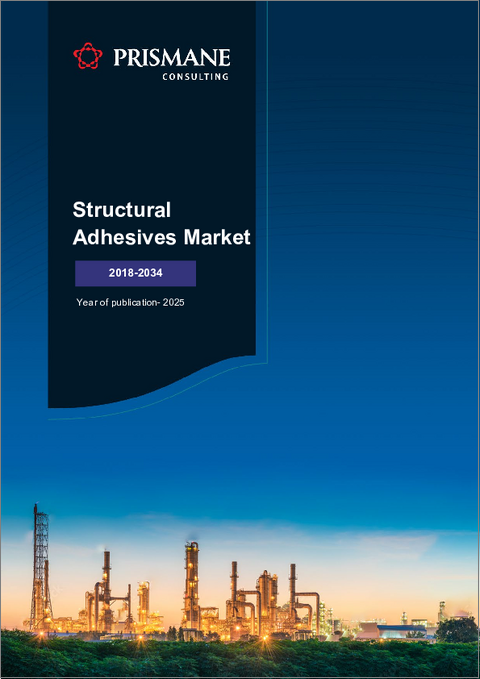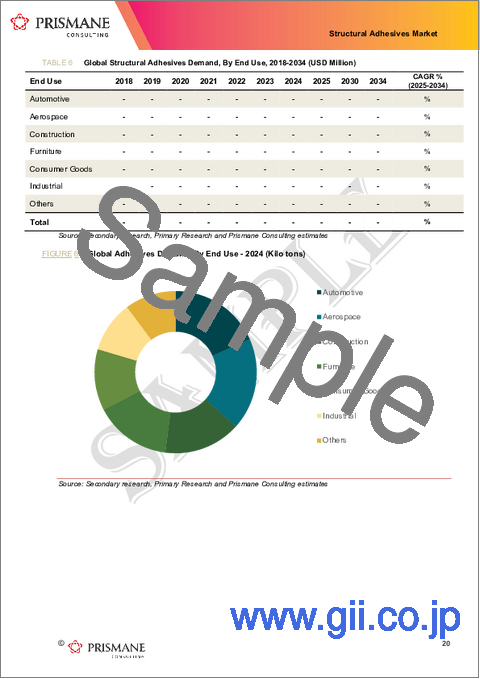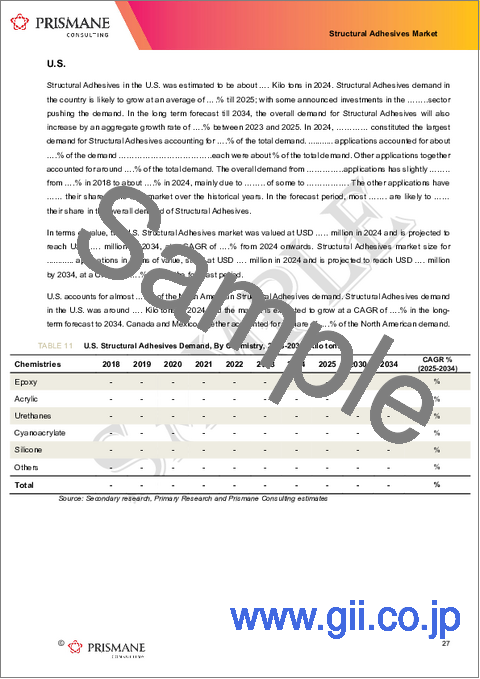|
|
市場調査レポート
商品コード
1761706
構造用接着剤の世界市場:需要と予測分析(2018年~2034年)Global Structural Adhesives Market Demand & Forecast Analysis, 2018-2034 |
||||||
|
|||||||
| 構造用接着剤の世界市場:需要と予測分析(2018年~2034年) |
|
出版日: 2025年05月23日
発行: Prismane Consulting
ページ情報: 英文 162 Pages
納期: 3~5営業日
|
全表示
- 概要
- 目次
世界の構造用接着剤の市場規模は、高い強度と耐久性を提供する高度な接合ソリューションの採用が産業界で進むにつれ、力強い成長を遂げています。構造用接着剤は、高い応力や荷重条件下で材料を接合するために設計された特殊な製品であり、溶接やボルト締めといった従来の機械的締結方法に代わる効果的な方法を提供します。同市場には、エポキシ、アクリル、ウレタン、シアノアクリレート、シリコーン、その他を含む様々なタイプの接着剤があり、それぞれが特定の産業用途や性能ニーズに合わせて調整されています。
構造用接着剤の需要、用途別
構造用接着剤の需要は、いくつかの主要産業で急速に増加しています。自動車産業は市場をリードしており、重い機械的ファスナーを強力で軽量な接着ソリューションに置き換えることで、自動車の軽量化、燃費の向上、安全性の強化に接着剤を使用しています。建設業界もまた、より迅速な組み立てと構造的安定性の向上のためにこれらの接着剤を適用することによって大きく貢献しています。家具製造は、耐久性と審美的に美しい接合部を確保する接着剤から利益を得る。航空宇宙およびエネルギー部門は、極端な温度や応力に耐える能力のために構造用接着剤に依存しており、船舶産業は湿気や腐食に耐性のある接着剤を要求しています。工業化、インフラ開発、軽量でありながら耐久性のある製品へのニーズが全体的に高まっていることが、世界の需要の推進力となっています。
主要メーカー
構造用接着剤市場は、複数の主要企業が技術革新と成長を推進しており、競争が激しいです。構造用接着剤市場の主要企業には、Henkel、3M、Dow Automotive、Illinois Tool Works、SIKA、Huntsman、Ashland、H.B. Fuller、Royal Adhesives、Unisealなどがあります。これらのメーカーは、製品の性能を向上させ、環境規制への適合を確保し、進化する顧客の要求に応えるため、研究開発に力を入れています。戦略的パートナーシップ、買収、製品ポートフォリオの拡大は、市場での地位を維持し、世界のリーチを拡大するための一般的な戦略です。先進的な接着技術や環境に優しい配合への投資は、競争優位性を維持するために不可欠です。
構造用接着剤の地域別需要分析
アジア太平洋地域は、中国、インド、日本、韓国などの国々における急速な産業成長、活況を呈する自動車製造、拡大するインフラ・プロジェクトに後押しされ、構造用接着剤市場を独占しています。この地域は、様々な製造および建設用途における接着剤の採用増加により、世界需要の最大シェアを占めています。北米と欧州は、製品の品質、安全性、環境の持続可能性に対する高い基準によって需要が安定している成熟市場です。これらの地域は、航空宇宙、エネルギー、船舶セクターの活動も活発で、安定した市場成長を支えています。ラテンアメリカと中東の新興国は、工業化の進展に伴い、さらなる拡大の機会を提供しています。
市場促進要因 - 自動車産業からの需要増加
構造用接着剤市場の主な促進要因は、特に自動車と航空宇宙産業において、軽量で耐久性のある接着ソリューションへのニーズが高まっていることです。メーカーは燃費や排ガス規制を満たすために車両の軽量化を求めており、接着剤はより重い機械的ファスナーの理想的な代替品となっています。これらの接着剤は、設計の柔軟性と安全性能の向上を可能にしながら、強力で信頼性の高い接着を提供し、普及に拍車をかけています。
市場の抑制要因 - 環境規制
市場は成長傾向にあるもの、環境規制や健康への懸念といった課題に直面しています。一部の接着剤には揮発性有機化合物(VOC)や有害物質が含まれており、製造時や塗布時にリスクをもたらす可能性があります。排出量の削減と作業員の安全保護を目的とした規制がますます厳しくなっているため、メーカーは製品の再製造を余儀なくされ、多くの場合コストが上昇します。さらに、接着剤で接着された材料のリサイクルが困難なため、使用済み材料の廃棄が複雑になり、環境意識の高い市場での一部の接着剤の使用が制限されています。これらの要因は市場の成長を鈍らせ、規制の厳しい地域での採用を妨げる可能性があります。
当レポートでは、世界の構造用接着剤市場について調査し、市場の概要とともに、タイプ別、用途別、地域・国別の動向、および市場に参入する企業のプロファイルなどを提供しています。
目次
第1章 イントロダクション
第2章 市場の概要
- 市場の進化
- 需要の概要
- 業界構造
- 戦略的な問題
- 最終用途の動向
- 成長予測
第3章 経済とエネルギーの見通し
- GDPと人口動態
- 金融政策と財政政策
- 原油生産と価格
- 天然ガス
- 電気料金
第4章 最終用途セクターのパフォーマンス
- 自動車
- 建設
- 航空宇宙
- エネルギー
- 船舶
- その他
第5章 構造用接着剤のイントロダクションと市場概要
- 製品説明
- グレードと特性
- 原材料
- 製造プロセス
- 環境問題
- バリューチェーン
- 用途
第6章 市場力学と業界の動向
- 市場力学
- 促進要因
- 抑制要因
- 機会
- 課題
第7章 世界の構造用接着剤の需要分析、種類別、用途別(数量、金額)(2018年~2034年)
- 戦略的課題とCOVID-19の影響
- 需要分析と予測(2018年~2034年)
- 要求
- 需要成長率(%)
- 駆動力分析
- 世界の構造用接着剤市場(タイプ別)
- エポキシ
- アクリル
- ウレタン
- シアノアクリレート
- シリコーン
- その他
- 世界の構造用接着剤市場(用途別)
- 自動車
- 建設
- 家具
- 航空宇宙
- エネルギー
- 船舶
- その他
第8章 需要分析と市場レビュー、地域別、国別(数量、金額)、(2018年~2034年)
- 戦略的課題とCOVID-19の影響
- 需要分析と予測(2018年~2034年)
- 需要
- 需要成長率(%)
- 構造用接着剤市場(タイプ別)
- 構造用接着剤市場(用途別)
注:需要分析は、下記の主要地域/国すべてについて提供されています。需要(消費量)は、国/地域ごとに、タイプ別と用途別に数量(キロトン)と金額(100万米ドル)で示されています。
- 北米
- 米国
- カナダ
- メキシコ
- 西欧
- ドイツ
- フランス
- イタリア
- 英国
- スペイン
- その他の西欧地域
- 中欧・東欧
- ロシア
- ポーランド
- その他の中欧・東欧地域
- アジア太平洋
- 中国
- 日本
- インド
- 韓国
- その他のアジア太平洋地域
- 中南米
- 中東・アフリカ
注:予測期間(2025年~2034年)の地域/世界の需要成長を算出するために、すべてのタイプと用途についてCAGRが計算されます。
第9章 価格分析
第10章 主要戦略課題とビジネス機会の評価
- 市場の魅力評価
- 将来およびターゲット市場調査
第11章 戦略的推奨事項と提案
第12章 企業分析
- 構造用接着剤メーカーのプロファイル/企業分析
- 3M
- Henkel
- Illinois Tool Works
- Huntsman
- Ashland
- SIKA
- Dow Automotive
- H.B. Fuller
- Royal Adhesives
- Uniseal
- その他のメーカー
注:このセクションには、企業情報、財務状況、製造拠点、事業地域が記載されています。財務状況は、SEC提出書類、年次報告書、または企業ウェブサイトで財務情報が入手可能な企業についてのみ記載しています。当レポートで報告されている財務状況はすべて米ドルで表示されています。その他の通貨で報告されている財務状況は、平均為替レートに基づいて換算されています。企業プロファイルには、製造業者、サプライヤー、販売業者が含まれる場合があります。
第13章 付録
- 需要- 地域
- 需要- 国
The global structural adhesives market is witnessing strong growth as industries increasingly adopt advanced bonding solutions that provide high strength and durability. Structural adhesives are specialized products designed to join materials under high stress and load conditions, offering an effective alternative to conventional mechanical fastening methods like welding or bolting. The market features a variety of adhesive types including epoxy, acrylic, urethanes, cyanoacrylate, silicone, and others, each tailored for specific industrial uses and performance needs.
Structural Adhesives Demand, by Application
Demand for structural adhesives is rising rapidly across several key industries. The automotive sector leads the market, using adhesives to reduce vehicle weight, improve fuel efficiency, and enhance safety by replacing heavy mechanical fasteners with strong, lightweight bonding solutions. The construction industry also contributes significantly by applying these adhesives for faster assembly and improved structural stability. Furniture manufacturing benefits from adhesives that ensure durable and aesthetically pleasing joints. Aerospace and energy sectors rely on structural adhesives for their ability to withstand extreme temperatures and stresses, while the marine industry demands adhesives resistant to moisture and corrosion. The overall increase in industrialization, infrastructure development, and the need for lightweight yet durable products continue to propel demand worldwide.
Key Manufacturers
The structural adhesives market is highly competitive with several major players driving innovation and growth and the leading companies in the structural adhesives market include Henkel, 3M, Dow Automotive, Illinois Tool Works, SIKA, Huntsman, Ashland, H.B. Fuller, Royal Adhesives, and Uniseal. These manufacturers focus heavily on research and development to improve product performance, ensure compliance with environmental regulations, and meet evolving customer requirements. Strategic partnerships, acquisitions, and product portfolio expansions are common strategies to maintain market position and expand global reach. Their investments in advanced adhesive technologies and eco-friendly formulations are critical to sustaining competitive advantage.
Regional Structural Adhesives Demand Analysis
The Asia-Pacific region dominates the structural adhesives market, fueled by rapid industrial growth, booming automotive manufacturing, and expanding infrastructure projects in countries like China, India, Japan, and South Korea. This region accounts for the largest share of global demand due to increasing adoption of adhesives in various manufacturing and construction applications. North America and Europe represent mature markets where demand is steady, driven by high standards for product quality, safety, and environmental sustainability. These regions also benefit from significant aerospace, energy, and marine sector activity, supporting consistent market growth. Emerging economies in Latin America and the Middle East offer further opportunities for expansion as industrialization spreads.
Market Driver: Rising demand from the automotive industry
The primary driver of the structural adhesives market is the growing need for lightweight and durable bonding solutions, especially in automotive and aerospace industries. Manufacturers seek to reduce vehicle weight to meet fuel efficiency and emissions regulations, making adhesives an ideal replacement for heavier mechanical fasteners. These adhesives provide strong, reliable bonds while allowing for design flexibility and improved safety performance, fueling widespread adoption.
Market Restraint: Environmental regulations
Despite positive growth trends, the market faces challenges from environmental regulations and health concerns. Certain adhesives contain volatile organic compounds (VOCs) and hazardous substances that can pose risks during production and application. Increasingly strict regulations aimed at reducing emissions and protecting worker safety force manufacturers to reformulate products, often increasing costs. Additionally, the difficulty in recycling adhesive-bonded materials complicates end-of-life disposal, limiting the use of some adhesives in eco-conscious markets. These factors can slow market growth and hinder adoption in heavily regulated regions.
Table of Contents
1. Introduction
- Scope
- Market Coverage
- Types
- Applications
- Regions
- Countries
- Years Considered
- Historical - 2018 - 2023
- Base - 2024
- Forecast Period - 2025 - 2034
- Research Methodology
- Approach
- Research Methodology
- Prismane Consulting Market Models
- Assumptions & Limitations
- Abbreviations & Definitions
- Conversion Factors
- Data Sources
2. Market Synopsis
- Market Evolution
- Demand Overview
- Industry Structure
- Strategic Issues
- End-use Trends
- Growth Forecast
3. Economic & Energy Outlook
- GDP and Demographics
- Monetary & Fiscal Policies
- Crude Oil Production and prices
- Natural Gas
- Electricity Prices
4. End-use Sector Performance
- Automotive
- Construction
- Aerospace
- Energy
- Marine
- Others
5. Introduction to Structural Adhesives and Market Overview
- Product Description
- Grades & Properties
- Raw Material
- Manufacturing Process
- Environmental Issues
- Value Chain
- Applications
6. Market Dynamics and Industry Trends
- Market Dynamics
- Drivers
- Restraints
- Opportunities
- Challenges
7. Global Structural Adhesives Demand Analysis, By Types, By Applications (Volume, Value) (2018-2034)
- Strategic Issues and COVID-19 Impact
- Demand Analysis and Forecast (2018- 2034)
- Demand
- Demand Growth Rate (%)
- Driving Force Analysis
- Global Structural Adhesives Market, By Types
- Epoxy
- Acrylic
- Urethanes
- Cyanoacrylate
- Silicone
- Others
- Global Structural Adhesives Market, By Applications
- Automotive
- Construction
- Furniture
- Aerospace
- Energy
- Marine
- Others
8. Demand Analysis and Market Review, By Region, By Country (Volume, Value), (2018- 2034)
- Strategic Issues and COVID-19 Impact
- Demand Analysis and Forecast (2018 - 2034)
- Demand
- Demand Growth Rate (%)
- Structural Adhesives Market, By Types
- Structural Adhesives Market, By Applications
Note: Demand Analysis has been provided for all major Regions / Countries as mentioned below. The demand (consumption) split by types and applications have been provided for each of the countries / regions in Volume (Kilo tons) and Value (USD Million).
- North America
- USA
- Canada
- Mexico
- Western Europe
- Germany
- France
- Italy
- United Kingdom
- Spain
- Rest of Western Europe
- Central & Eastern Europe
- Russia
- Poland
- Rest of Central & Eastern Europe
- Asia-Pacific
- China
- Japan
- India
- South Korea
- Rest of Asia-Pacific
- Central & South America
- Middle East & Africa
Note: CAGR will be calculated for all types and applications to arrive at the regional / global demand growth for the forecast period (2025 - 2034)
9. Pricing Analysis
10. Key Strategic Issues and Business Opportunity Assessment
- Market Attractiveness Assessment
- Prospective & Target Market Study
11. Strategic Recommendation & Suggestions
12. Company Analysis
- Structural Adhesives Manufacturers Profiles/ Company Analysis
- Basic Details
- Headquarter, Key Markets
- Ownership
- Company Financial
- Manufacturing Bases
- Global Turnover
- Total Employee
- Product Portfolio / Services / Solutions
- Key Business Strategies adopted and Prismane Consulting Overview
- Recent Developments
- Companies Covered -
- 3M
- Henkel
- Illinois Tool Works
- Huntsman
- Ashland
- SIKA
- Dow Automotive
- H.B. Fuller
- Royal Adhesives
- Uniseal
- Other Manufacturers
Note: This section includes company information, company financials, manufacturing bases and operating regions. Company financials have been mentioned only for those companies where financials were available in SEC Filings, annual reports, or company websites. All the reported financials in this report are in U.S. Dollars. Financials reported in other currencies have been converted using average currency conversion rates. Company profiles may include manufacturers, suppliers, and distributors.
13. Appendices
- Demand - Regions
- Demand - Countries





